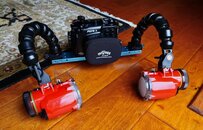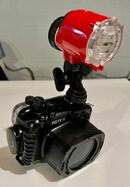I've seen both Sea and Sea and Inon strobes over 10-20+ years out in the field. Both work when the battery compartment is closed up correctly.
The biggest mistake I've seen is greasing the o-rings.
Both brands use a colored silicone one and need the proper lube.
The Sea and Sea battery door being opaque you can't see it slide into position. The black battery door is "keyed" only going in one way due to a little raised tip that goes into a molded hole down in the battery compartment.
I've seen people try and force the door in (NOT GOOD !!!) and finally realize they need to rotate it 90 - 180 degrees and then it'll drop in correctly. Being a colored o-ring I don't know how anyone could miss it if dry and popping out

Maybe rushing assembly or ????
The Inon clear door I think has an advantage but without a shiny slippery coating on the outside edge as you screw the door in it can twist or roll

I have also seen people rush and start to cross thread the cap. If your YELLOW o-ring has a enough lube (shiny, NOT gloppy) you should be able to either press in slightly making sure the threads are aligned and then thread it on.
I currently own two Inon S220 and have used the previous S2000 and Z330 units over a decade.
Too little silicone grease and you'll feel resistance from dry spots, if so STOP......Unscrew and re-grease the outer edge so the cap threads on easily. The Inon manual even states to put some o-ring grease inside the clear cap lip the o-ring seats against.
When it bottoms out STOP.....It doesn't have to be tight. You can SEE the o-ring is sealed which I like on the Inon brand strobes.
Just a few more insights seeing lots of gear out in the field over many, many trips

David Haas











